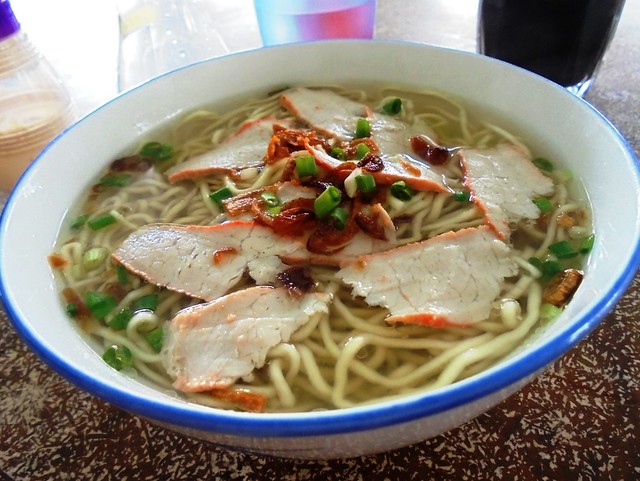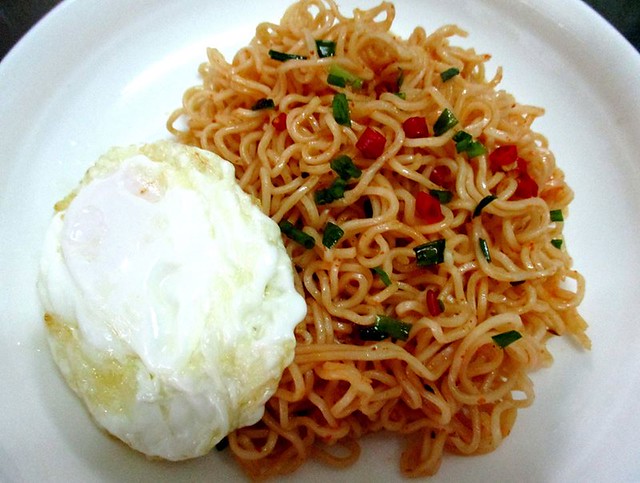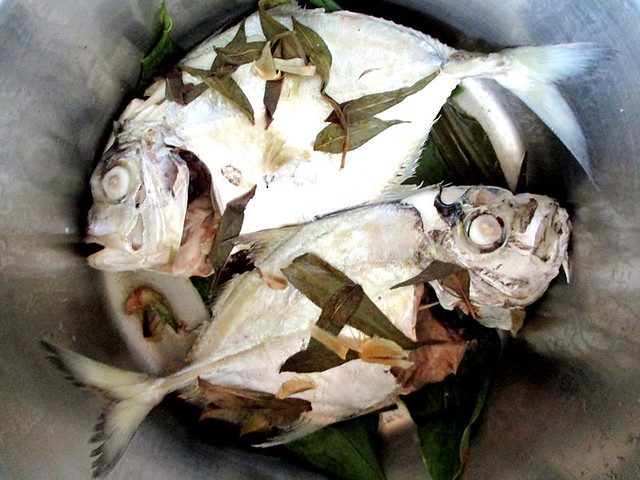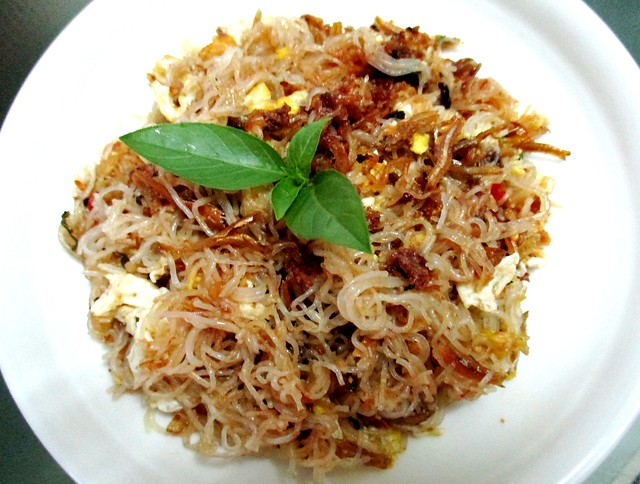This is our own made-in-Sibu Daddy Mee…

…instant noodles. There has been a slight improvement, I noticed – the packaging is now some kind of thin aluminium foil not the flimsy plastic that they had in the past but other than that, it is still the same.
In case you’re wondering, the 3-in-1 does not mean there are three things you can get in one packet though there are the noodles and a sachet of seasoning plus a little pack of shallot oil inside. What it actually means is that you can have it in three different ways – in soup, dry or just eat it like that as a snack.
I rather like the soup version – it brings to mind the ching th’ng mee (noodles in clear soup)…

*Archive photo*
…available at all the kampua noodle stalls in town, minus the meat, of course, unless you add your own.
However, I did try serving it dry not too long ago and I thought it was nice. My missus was never a fan – she insisted the noodles tasted like some kind of plain biscuit but she did seem to enjoy it like this…

…tossed with half the sachet of seasoning (do not use the whole packet or it will be too salty), the shallot oil plus a bit of the ABC Extra Hot Chili Sauce and garnished with chopped spring onions and sliced cili padi.
For one thing, people keep saying that when eating instant noodles, one must boil the noodles first and drain before adding to the soup. This way, that is taken care of as you would have done that before tossing with the ingredients.
Moving on from there, this is a different way of cooking that some of you may not be familiar with. Like how the ethnic population here have their pansoh – meat or seafood cooked in bamboo tubes over a hot charcoal fire, we have our masak kuden, masak meaning cook and kuden, if I am not wrong, refers to the pot. I am not sure if it is Melanau but it has been in my maternal side of the family for as long as I can remember. This is a very simple kampung-style cooking method whereby you line the bottom of the pot with banana leaf, rub the fish with salt and place it on top, cover the pot and put it over a very very small fire to slow cook until the juices come out and the fish is cooked.
I did not have any banana leaf so I used kunyit (turmeric) leaves instead and I could not resist throwing in a bit of ginger and daun kesum…

It was raining that day, otherwise I would have gone out to set some serai (lemon grass) as well.
I’ve baked fish with these ingredients wrapped in aluminium foil before and it was very nice too but of course, in the old days, they did not have an electric oven so traditionally, this was how they did it. What would separate the men from the boys would be the type of fish used and how fresh it is.
Last but not least, I was going to fry some leftover rice that I spotted sitting in the fridge that morning but it turned out that there was tang hoon (glass noodles) in one of the plastic tubs, not rice and I went ahead and fried that instead…with belacan (dried prawn paste)…

…and it turned out really nice – I thought it was nicer than rice or bihun (rice vermicelli), a welcome change indeed.
I do think that sometimes, it is good to stray away from the well-trodden paths and do things in a different way instead of following the same ol’ boring recipes day in and day out. What do you think?

I am partial with the way you cooked the white pomfret. I shall take a leaf from your book. I assume it was a highly fragrant dish. Give it a twist and cooked it over a charcoal.
Have you try smoking it using the same ingredients?
Take it to another level by wrapping it with galangal leaves and cooked it over a charcoal.
That is one thing I do not plant – galangal or what we call langkuas. I used to and it went wild, grew so rampantly, went under the fence into the neighbour’s backyard. I had no choice but to get rid of it. Anyway, we just use very very little of it each time – cannot use a lot, the smell is too strong so we just buy RM1, keep in the freezer…can use for a very very long time, no need to plant our own.
Cooking with charcoal is nicer, they all say…but I don’t. Can’t stand the heat – barbecue grill was rusting away, my missus threw it away. Can’t remember the last time we had one – it’s too hot here for that. My aunt’s helper used to do that, not charcoal but cook masak kuden style using firewood…in a little hut in the backyard of their kampung house. We do not have that luxury in our more modern-style houses…but at least, we have landed property unlike many people elsewhere.
Ooo I’ve not heard of daddy mee – cool name – is it as good as Maggi and mamee 😀
Of course! Especially Maggi. I tried the kolo mee and it was a lot more expensive than most – that’s a ripped off! I simply refused to blog about it.
The soup looks good! I am having a can of vegetable soup for supper this evening, as I am not feeling very well.
Oh dear! Do take care, get well soonest.
I always search for things that are made locally. I’d buy some of these noodles if I visit. 🙂
My friend from NZ took a few packets home and she loved it. Regretted not carting the whole box home, did not even realise at the time it was made in Sibu!
Mee Daddy, my favourite too. I like both flavour, chicken & curry. Chicken flavour, I prefer to have dry version. Am not an adventurous person so I guess I won’t cook other ways. Tang hoon looks well fried but sad I can’t do it.
Why not? Especially now with non-stick pans, no problem at all if you can fry rice, mee, kway teow and bihun without a hitch. Must drain really dry before frying. Mee sua may be a challenge, too soft.
I thought you would want to try masak kuden. You may like it – like my kampung-style masak kunyit. All you need is a pot, a banana leaf and some salt – so healthy, no oil, no msg!
Experimentation can lead to pleasant results. Your tang hoon dish looks very nice.
It tasted great! Perhaps I can try frying it in some other ways, different recipes…like one that they call the fake dry fried shark’ fins dish.
Yes, I do agree that it is good to try different styles and ingredients and deviate from the conventional. Sometimes the results are quite pleasing and of course sometimes it doesn’t work. Now, I would not have thought about frying tanghoon with belacan. Since you have discovered how good it is, I am game to try it as well!
Go ahead. I did it with bihun before and it was very nice:
https://suituapui.wordpress.com/2015/05/17/beg-to-differ/
I thought this was much nicer!
I never try that instant noodle before. Must grab a pack and try one day. At least my kids can help me eat it as snack. ^^
Pansoh. Saw pansoh chicken in the menu when dining in Permai yesterday but did not order that. I prefer pork pansoh.
Your mihun looked good. Mihun anytime for me.
That was tang hoon, nicer than bihun!
I am raring to try the Kuden Way. For Daddy Mee, always love the soupy version. All my life, I have never cooked tanghoon.
Can give it a try. Have you tried the dry sharks’ fins imitation, what they call “fake sharks’ fins”? That’s tang hoon. Maybe I can try and cook one of these days and blog about it.
Would love to taste all the above that you cooked… Homecooked are always the best!
You will have to come here again…for that special privilege. Hehehehe!!!!!